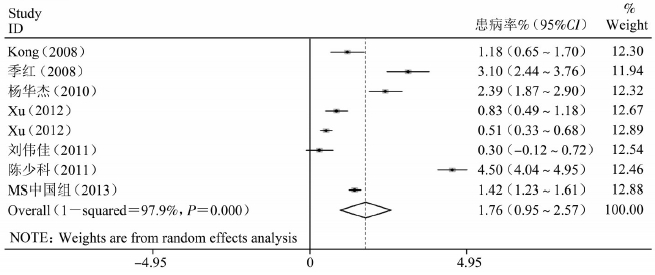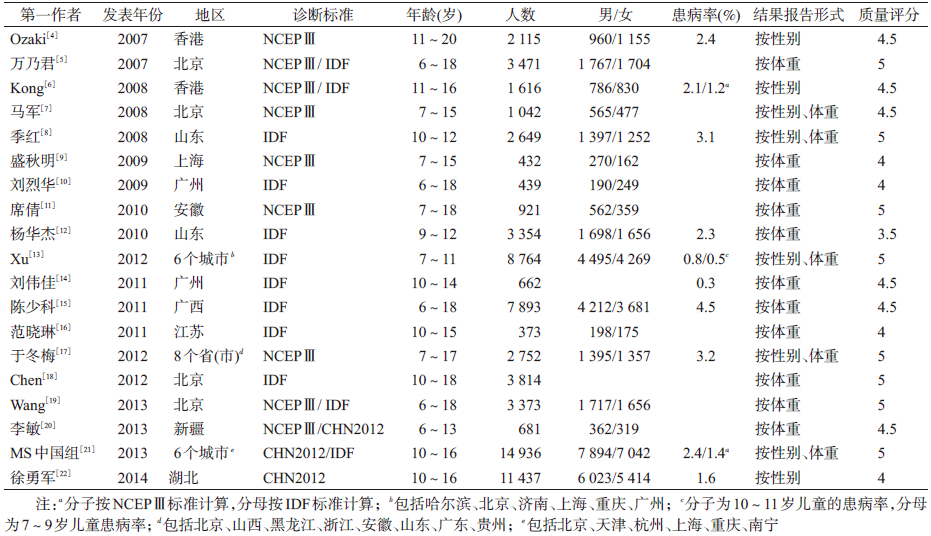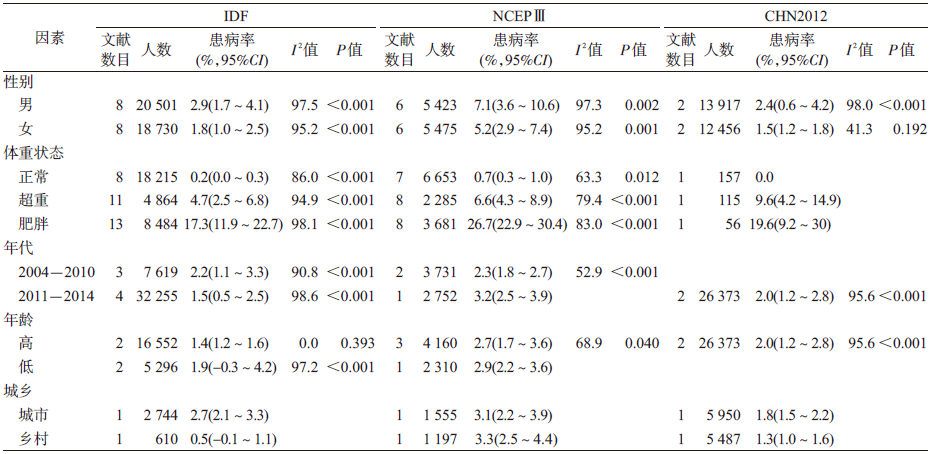文章信息
- 叶佩玉, 闫银坤, 丁文清, 董虹孛, 刘琴, 黄贵民, 米杰. 2015.
- Ye Peiyu, Yan Yinkun, Ding Wenqing, Dong Hongbo, Liu Qin, Huang Guimin, Mi Jie. 2015.
- 中国儿童青少年代谢综合征患病率Meta分析
- Prevalence of metabolic syndrome in Chinese children and adolescents: a Meta-analysis
- 中华流行病学杂志, 2015, 36(8): 884-888
- Chinese Journal of Epidemiology, 2015, 36(8): 884-888
- http://dx.doi.org/10.3760/cma.j.issn.0254-6450.2015.08.025
-
文章历史
- 投稿日期:2015-01-18
2. 宁夏医科大学公共卫生学院
2. School of Public Health, Ningxia Medical University
MS强调多种代谢异常聚集对健康的危害[1]。儿童期MS能够预测成年期MS和2型糖尿病的发生概率[2]。国内已有很多学者在不同地区对儿童MS患病率进行流行病学调查,但大样本多中心的随机抽样调查仍相对缺乏。本文采用Meta分析方法,通过检索筛查将既往文献按不同标准分类合并,得出一个基于较大样本量、可信度高、代表性好的参考值,以全面了解我国儿童青少年MS流行趋势,采取积极的防治策略控制MS的发生,促进儿童青少年健康成长。
资料与方法1.文献检索:系统检索中国期刊全文数据库(CNKI)、万方数据资源系统(Wanfangdata)、维普数据库(VIP)中2004-2014年间所有关于儿童青少年MS患病率研究的文献。检索策略为以主题词、摘要、题名(或篇名)及关键词分别进行“儿童”或“青少年”+“代谢综合征”+“患病率”检索。外文文献检索数据库PubMed中收录的2004-2014年相关且研究现场为中国地区的外文文献。检索策略为“metabolic syndrome”[tiab] AND(“children”[tiab] OR “adolescents”[tiab])AND prevalence AND China。此外,辅助采用文献追溯法,尽可能查找到详尽的资料。
2. 文献筛选:纳入标准为①研究对象均来自中国地区;②原始数据文献;③研究对象6~20岁;④明确报告儿童青少年MS诊断标准;⑤报告样本数和患病率。排除标准为①非中国地区的儿童青少年MS流行病学研究;②研究设计不合理,统计学方法错误;③重复发表;④综述等。通过阅读2004-2014年发表的相关文献题目及摘要进行初筛,再阅读全文进行二次筛查,然后按纳入及排除标准剔除不合格的文献。此过程由2名研究者独立完成,对有不同意见的文献交由第3人审核决定是否纳入,如≥2篇文献来源于同一人群,选择报告最全面的一篇。
3. 文献质量评价:根据加强观察性流行病学研究报告规范(STROBE)[3]声明中横断面研究评价标准对文献进行质量评价,共5条标准包括①设计科学;②研究目的明确;③样本代表性好;④儿童青少年MS诊断标准明确;⑤统计学方法合理。分别采用“是”、“否”、“不清楚”归类,分别给予“1”、“0”、“0.5”分。总分>4分为高质量,总分≤4分为低质量。
4. 数据提取与分析:阅读纳入文献全文,记录每篇文献的第一作者、发表年份、地区、诊断标准、年龄、样本数(男/女)、患病率、记录结果报告形式及质量评分等数据,按照统一表格,由2位评价者独立记录,如遇不一致经讨论决定。如果同一篇文献分不同标准报道,则将文献拆分为多个研究并摘录其原始数据。采用Stata 12.0软件进行异质性检验,如无异质性(I 2<50%),采用固定效应模型进行合并分析;若存在异质性(I 2≥50%),采用随机效应模型进行合并分析。基于不同MS诊断标准,计算MS患病率及其95%CI,依据性别、体重状态等因素进行亚组分析。采用漏斗图及Egger检验发表偏倚,排除其中任一篇对合并效应值的影响进行敏感性分析。
结 果1. 文献特征:最初检索得到198篇文献(其中英文文献23篇),排除重复文献57篇、不符合本研究目的文献112篇、综述等10篇,最终纳入19篇文献(5篇英文、14篇中文)[4, 5, 6, 7, 8, 9, 10, 11, 12, 13, 14, 15, 16, 17, 18, 19, 20, 21, 22]。文献涵盖了中国11个省、4个直辖市及香港特别行政区的儿童青少年。按国际糖尿病联盟(IDF)标准[23]、美国国家胆固醇教育计划成人治疗专家组Ⅲ修订(NCEPⅢ)标准[24]、中国儿童青少年代谢综合征定义和防治建议(CHN2012)标准[25]报告的文献分别为分别为13、9、3篇,总数70 724人,其中10篇文献报告了总患病率,8篇文献按性别报告,16篇文献按体重状态报告,高质量文献14篇,低质量文献5篇,见表 1。
2. 儿童青少年MS患病率:Meta分析显示,按IDF标准中国儿童青少年MS患病率为1.8%(图 1);按NCEPⅢ标准患病率为2.6%(图 2);按CHN2012标准患病率为2.0%。Egger检验显示,均未存在发表偏倚(P>0.05);敏感性分析结果显示,去除任何一篇文献对合并效应值无影响。3. 亚组分析:按IDF标准,男生的MS患病率为2.9%,女生为1.8%,正常体重、超重和肥胖儿童MS患病率分别为0.2%、4.7%和17.3%;按NCEPⅢ标准,男生的MS患病率为7.1%,女生为5.2%,正常体重、超重和肥胖儿童MS患病率分别为0.7%、6.6%和26.7%;按CHN2012标准,男生的MS患病率为2.4%,女生为1.5%,正常体重、超重和肥胖儿童MS患病率分别为0、9.6%和19.6%,见表 2。按3种诊断标准,均呈现MS患病率男生>女生,肥胖组>超重组>正常组。
 |
| 图1 基于IDF标准的中国儿童MS合并患病率的Meta分析 |
 |
| 图2 基于NCEPⅢ标准的中国儿童MS合并患病率的Meta分析 |
本研究共纳入2004-2014年发表的19篇文献,通过Meta分析方法描述了我国儿童青少年MS流行现状。自1988年Reaven[26]提出X-综合征的概念并于1997年被命名为MS以来,关于MS定义、具体组分、各组分指标的异常阈值备受争议,MS诊断标准也在不断更新完善,同一人群采用不同标准诊断导致人群MS患病率可能不同。目前国内最常用的儿童MS诊断标准有IDF标准、NCEPⅢ标准和CHN2012标准,本研究显示,采用以上3个标准,儿童MS患病率分别为1.8%、2.6%和2.0%。万乃君等[5]研究结果显示,采用NCEPⅢ标准诊断MS的患病率高于采用IDF标准诊断MS的患病率;儿童MS中国工作组于2010年对6个城市儿童调查研究发现[21],采用CHN2012标准诊断MS的患病率高于采用IDF标准诊断MS的患病率。这3种MS诊断标准都有其各自特点,应用NCEPⅢ标准诊断MS最为敏感,IDF标准诊断MS最为保守,CHN2012标准居中。而CHN2012标准于2012年刚刚提出,还未得到广泛应用,有待在更多的研究中应用比较得出确切结论,在比较MS患病率地区差异及时间变化趋势时,应注意不同标准诊断MS的差异。
学者普遍认为,肥胖是MS最重要的危险因素。本研究按照不同体重状态进行亚组分析,结果显示,采用任何一种标准,在正常体重、超重、肥胖儿童中MS患病率逐渐上升。MS的病因和发病机制十分复杂[27, 28],但大多数研究显示肥胖与MS关系密切,脂肪组织会分泌一系列脂肪因子,如瘦素、脂联素及抵抗素等,脂联素可以增强胰岛素敏感性、降低炎症反应和抗动脉粥样硬化作用,有研究证实脂联素水平与内脏脂肪含量呈负相关关系,肥胖尤其是内脏肥胖时分泌的脂肪因子谱发生变化,使代谢调节功能紊乱并降低抗炎作用,使机体处于慢性炎症状态,导致MS发生。提示儿童MS的防治主要是对超重、肥胖儿童进行筛查及干预,预防肥胖发生是防治MS的关键环节[29]。此外,采用任一标准诊断,男生MS患病率高于女生,提示应关注男童健康。在纳入本研究的文献中,有3篇[12, 17, 22]报道了城市、乡村儿童MS患病率,其中2篇表现为城市高于乡村,1篇城乡间无差异,可能是与经济、文化不同有关,但由于文献数量及样本量过小,结论有待于大样本进行验证。
本研究利用Meta分析的方法对所收集的资料进行分析,除Meta分析方法本身的缺点之外,还有两点不足:①由于儿童青少年MS诊断标准多样,国内现有的文献量有限,单一标准分类下样本量不足够大,结论有待在以后的研究中继续进行验证;②由于对年代、年龄、城乡等因素进行亚组分析文献数量太少,故缺乏有效的时间趋势研究,亦未能充分考虑年龄、城乡等其他因素对儿童MS患病率的影响,可能对结果有一定的影响。
综上所述,MS已在我国儿童青少年中广泛流行,应加大对儿童青少年MS的重视和防治,预防儿童肥胖是降低MS发生的核心措施,因此对儿童超重、肥胖应尽早筛查并干预,积极开展健康教育,培养健康的生活行为方式,以期减少儿童MS的发生。
| [1] Goodman E, Daniels SR, Morrison JA, et al. Contrasting prevalence of and demographic disparities in the World Health Organization and National Cholesterol Education Program Adult Treatment Panel Ⅲ definitions of metabolic syndrome among adolescents[J]. J Pediatr, 2004, 145(4):445-451. |
| [2] Morrison JA, Friedman LA, Wang P, et al. Metabolic syndrome in childhood predicts adult metabolic syndrome and type 2 diabetes mellitus 25 to 30 years later[J]. J Pediatr, 2008, 152(2):201-206. |
| [3] Vandenbroucke JP, Von Elm E, Altman DG, et al. Strengthening the Reporting of Observational Studies in Epidemiology (STROBE): explanation and elaboration [J]. Epidemiology, 2007, 18(6):805-835. |
| [4] Ozaki R, Qiao Q, Wong GWK, et al. Overweight, family history of diabetes and attending schools of lower academic grading are independent predictors for metabolic syndrome in Hong Kong Chinese adolescents[J]. Arch Dis Child, 2007, 92(3):224-228. |
| [5] Wan NJ, Mi J, Wang TY, et al. Metabolic syndrome in overweight and obese school children in Beijing[J]. Chin J Pediatr, 2007, 45(6):417-421. (in Chinese) 万乃君, 米杰, 王天有, 等. 北京市超重和肥胖学龄儿童中代谢综合征的流行特征[J]. 中华儿科杂志, 2007, 45(6):417-421. |
| [6] Kong AP, Ko GT, Ozaki R, et al. Metabolic syndrome by the new IDF criteria in Hong Kong Chinese adolescents and its prediction by using body mass index[J]. Acta Paediatr, 2008, 97(12):1738-1742. |
| [7] Ma J, Zhang SW, Wu SX, et al. Prevalence of metabolic syndrome among children with different nutritional status in Beijing[J]. Chin J Sch Health, 2008, 29(2):103-105. (in Chinese) 马军, 张世伟, 邬盛鑫, 等. 不同营养状况儿童代谢综合征发生情况分析[J]. 中国学校卫生, 2008, 29(2):103-105. |
| [8] Ji H. Study of child metabolism syndrome in Ji'nan[D]. Ji'nan:Shandong University, 2008. (in Chinese) 季红. 济南市儿童代谢综合征的调查研究[D]. 济南:山东大学, 2008. |
| [9] Sheng QM, Li WG, Zhang HT, et al. Prevalence of metabolic syndrome in overweight and obesity children and adolescents[J]. J Clin Pediatr, 2009, 27(4):359-362, 367. (in Chinese) 盛秋明, 李卫国, 张海涛, 等. 超重肥胖儿童青少年代谢综合征流行现状调查[J]. 临床儿科杂志, 2009, 27(4):359-362, 367. |
| [10] Liu LH, Li YB, Yan JH, et al. Prevalence of metabolic syndrome among overweight and obese children and adolescents in Guangzhou[J]. Chin J General Pract, 2009, 8(10):698-701. (in Chinese) 刘烈华, 李延兵, 严晋华, 等. 广州市肥胖及超重儿童青少年代谢综合征患病情况调查[J]. 中华全科医师杂志, 2009, 8(10):698-701. |
| [11] Xi Q, Liu C, Liu G, et al. Case-control study on risk factors of metabolic syndrome in children and adolescent of Bengbu[J]. Chin J Sch Health, 2010, 31(12):1483-1485. (in Chinese) 席倩, 刘超, 刘刚, 等. 蚌埠市儿童青少年代谢综合征危险因素病例对照研究[J]. 中国学校卫生, 2010, 31(12):1483-1485. |
| [12] Yang HJ, Liu YL, Zhou LS, et al. The prevalences and risk factors of obesity and metabolic syndrome in children[J]. Chin J Prev Med, 2010, 11(8):766-769. (in Chinese) 杨华杰, 刘蕴玲, 周聊生, 等. 济南市儿童肥胖和代谢综合征患病率及其影响因素[J]. 中国预防医学杂志, 2010, 11(8):766-769. |
| [13] Xu H, Li Y, Liu A, et al. Prevalence of the metabolic syndrome among children from six cities of China[J]. BMC Public Health, 2012, 12(1):13. |
| [14] Liu WJ. Epidemiological study of metabolic syndrome and correlate impacting factors among children in urban area in Guangzhou city[D]. Guangzhou:Southern Medical University, 2011. (in Chinese) 刘伟佳. 广州市城区儿童代谢综合征流行特征及相关影响因素的研究[D]. 广州:南方医科大学, 2011. |
| [15] Chen SK, Luo JS, Qin YF, et al. Epidemiological study on the association between obesity with metabolic syndrome in obese children and adolescents of Nanning city, Guangxi[J]. Chin J Epidemiol, 2011, 32(10):969-972. (in Chinese) 陈少科, 罗静思, 秦映芬, 等. 南宁地区儿童青少年肥胖与代谢综合征相关性的流行病学研究[J]. 中华流行病学杂志, 2011, 32(10):969-972. |
| [16] Fan XL, Su RT, Han XJ, et al. Prevalence of metabolic syndrome in adolescents and analysis of risk factors[J]. Chin Med, 2011, 6(5):549-551. (in Chinese) 范晓琳, 苏如婷, 韩晓骏, 等. 青少年代谢综合征的现状及相关影响因素分析[J]. 中国医药, 2011, 6(5):549-551. |
| [17] Yu DM, Zhao LY, Piao JH, et al. Prevalence of the metabolic syndrome and its main influencing factors in 7-17 years old children and adolescents in 8 provinces[J]. Chin J Health Educ, 2012, 28(6):431-433, 437. (in Chinese) 于冬梅, 赵丽云, 朴建华, 等. 8 省市儿童青少年代谢综合征流行现况及其主要影响因素[J]. 中国健康教育, 2012, 28(6):431-433, 437. |
| [18] Chen F, Wang Y, Shan X, et al. Association between childhood obesity and metabolic syndrome:evidence from a large sample of Chinese children and adolescents[J]. PLoS One, 2012, 7(10):e47380. |
| [19] Wang Q, Yin J, Xu L, et al. Prevalence of metabolic syndrome in a cohort of Chinese school children:comparison of two definitions and assessment of adipokines as components by factor analysis[J]. BMC Public Health, 2013, 13(1):249. |
| [20] Li M, Zhang T, Xu PR. Epidemiological characteristics of metabolic syndrome among Kazakh children aged from 6 to 13 in Xinjiang, China[J]. Chin J Epidemiol, 2013, 34(4):336-341. (in Chinese) 李敏, 张涛, 徐佩茹. 新疆哈萨克族6-13岁超重和肥胖儿童代谢综合征特征分析[J]. 中华流行病学杂志, 2013, 34(4):336-341. |
| [21] Chinese Work Group of Pediatric Metabolic Syndrom. Prevalence of metabolic syndrome of children and adolescent students in Chinese six cities[J]. Chin J Pediatr, 2013, 51(6):409-413. (in Chinese) 儿童代谢综合征中国工作组. 中国六城市学龄儿童代谢综合征流行现状研究[J]. 中华儿科杂志, 2013, 51(6):409-413. |
| [22] Xu YJ. Prevalence of metabolic syndrome among children and adolescent students aged 10 to 16 in Xian'an[J]. J Military Surgeon Southwest Chin, 2014, 16(4):401-402. (in Chinese) 徐勇军. 咸安区10-16岁青少年代谢综合征患病率的调查研究[J]. 西南军医, 2014, 16(4):401-402. |
| [23] Zimmet P, Alberti G, Kaufman F, et al. The metabolic syndrome in children and adolescents[J]. Lancet, 2007, 369(9579):2059-2061. |
| [24] Cook S, Weitzman M, Auinger P, et al. Prevalence of a metabolic syndrome phenotype in adolescents:findings from the third National Health and Nutrition Examination Survey, 1988-1994[J]. Arch Pediatr Adolesc Med, 2003, 157(8):821-827. |
| [25] The Society of Pediatrics, The Subspecialty Group of Endocinologic, Hereditary and Metabolic Diseases, The Subspecialty Group of Cardiology, The Subspecialty Group of Child Health Care, Chinese Medical Association, et al. The definition and prevention recommends of metabolic syndrome in Chinese children and adolescents[J]. Chin J Pediatr, 2012, 50(6):420-422. (in Chinese) 中华医学会儿科学分会内分泌遗传代谢学组, 心血管学组, 儿童保健学组, 等. 中国儿童青少年代谢综合征定义和防治建议[J]. 中华儿科杂志, 2012, 50(6):420-422. |
| [26] Reaven GM. Role of insulin resistance in human disease[J]. Diabetes, 1988, 37(12):1595-1607. |
| [27] Lambert M, Paradis G, O'Loughlin J, et al. Insulin resistance syndrome in a representative sample of children and adolescents from Quebec, Canada[J]. Int J Obes, 2004, 28(7):833-841. |
| [28] Duncan GE, Li SM, Zhou XH. Prevalence and trends of a metabolic syndrome phenotype among U.S. adolescents, 1999-2000[J]. Diab Care, 2004, 27(10):2438-2443. |
| [29] Wang Y. Metabolic syndrome in children and adolescents[J]. Chin J Med, 2010, 45(11):8-10. (in Chinese) 汪翼. 儿童代谢综合征[J]. 中国医刊, 2010, 45(11):8-10. |
 2015, Vol. 36
2015, Vol. 36




